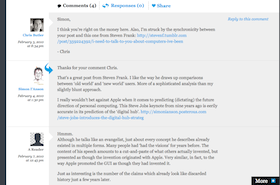My last couple of posts looked at several ways you can assess your content’s value, including figuring out what the bounce rate really shows and considering when time on page and exit rate matter. Each of those metrics lives pretty firmly within the realm of numbers and analytics. But in some cases, and for some kinds of content in particular, the full story of value can go beyond just the numbers. This post focuses on a few more qualitative indicators of what your content is accomplishing.
This is a good time to say a little more about value (although, hey, it probably would have been even better to do earlier in this series…). Like many of the metrics that can be used to measure it, “value” will vary depending on the specific piece of content you’re looking at and what its goals are. Not every visit to your site will result in a sale; even on the most successful site, there won’t be a one-to-one relationship between sessions and conversions. So rather than just selling more of whatever it is you’re selling, your site will have a more multifaceted impact: introducing new people to your brand, even if they’re not ready to buy in yet; making it easier to find and use your product in the real world; re-earning the loyalty of the people who have already found you; demonstrating your thought leadership within your industry: the list can and will vary. In the big picture, what your site should really be doing is helping you build relationships.
On a content-rich site, a lot of the content is going to be doing that kind of gradual relationship-building work—introducing your brand, developing your reputation, letting people get to know you and your expertise. The factors I’m talking about in this post primarily apply to that kind of content, rather than the pages that represent end goals. For the most part, a blog post or newsletter would be the representative page to think about as an example. That’s not to say these factors can’t apply to other kinds of content—someone could just as well share a product via Facebook as a post, and if they do, that’s great too. But here, the main idea is: beyond the numbers you get from analytics, what other things can show whether your content is doing the relationship-building work that you want it to?
Comments
This one, of course, only applies if commenting is available for the page in question. For the most part, it’s pretty straightforward: if there’s a good conversation going on in the comments, then somebody thought your content was worth discussing. Good. A couple things to note here.
One, glowing notes of approval are not the only indications of success. Sure, it’s satisfying to get a bunch of responses saying, “Great job! We think you’re the best!” But somebody taking the time to argue with you can also be a sign that you’ve succeeded in engaging them. Newfangled’s recommendation (and our own approach) is almost always to leave up critical comments, but make sure to respond to them. That approach has several advantages: it shows that you can handle a counterargument; it answers questions that other people may have also had, even if only one person voiced them; it demonstrates your or your company’s level of engagement in your industry, or responsiveness to users; and it keeps the conversation in a venue that you can stay aware of and control the tone of. Sure, there are exceptions; if a commenter is engaging in ad hominem attacks, using derogatory language, or otherwise creating a bad environment for other readers and potential commenters, you have no obligation to let them use your site to be a jerk. And of course spam’s gotta go. But other than those extreme cases, leaving up a critical comment is usually the best bet, because the reasons listed above are some of the same reasons why commentable content is valuable in the first place. Engaging with the comments is a chance to amplify that value.
The other point to note is that, by its nature, B2B content is less likely to get comments than many other kinds of content. Much (not all) commenting is driven by extreme emotions (you love or hate Apple, and so you comment on a post about their latest product) or by a sense of community, and both of those motivators will apply less to people’s work lives than their personal lives. So if no one comments on a post, it doesn’t mean they hate you, or that no one bothered to read it. In that case, you can go back to the numbers and look at things like bounce rate, time on page, etc to get a sense of whether they’re reading and engaging.
For those reasons, I would say the best way to use comments as an indicator of the content’s value is not by numbers, nor by how many of them are agreeing with you (although, again, both of those things can be nice), but by the quality of the conversation that’s going on. With blogs and other commentable content, a big part of the goal is usually to take part in the discussions that are important in your industry. If people are saying smart things in response to your post, that just increases its role in shaping the discourse.

YouTube: lots and lots of comments, most of them stupid.

A good conversation: a couple of solid comments, one somewhat argumentative, both replied to. Full post here.
Again, not all content will have commenting, nor would it make sense for every page to. The same general considerations apply anytime you’re providing users with a way to engage onsite. Product reviews, discussion forums—whatever tools you’re providing for that content, are people using them?
Social Success
Even if you are providing commenting ability, not all online discussion of your content will happen on your site. Another way a given post or article can affect the conversations in your industry is by getting traction via social media. Are people tweeting your post or sharing it on Facebook or LinkedIn? Fantastic. Has someone taken your post as a starting point for a blog post of their own? That’s a big compliment.
Back to the idea that content can contribute value in multiple ways: there are also multiple ways getting shared via social media can help your content contribute to your site, whether it’s by getting a shopper to share a product with a friend who might then become another shopper, or by establishing your reputation as a smartie people should listen to (and eventually consider working with), or something in the middle of that spectrum. Because social media is the open-ended thing that it is, it can feed into the big picture of relationship-building in many ways. It won’t always make sense for all companies to directly participate in the same ways (believe it or not, a Facebook page might not be the best thing for you). But you should take the time to be aware of what people are saying in response to your content. Otherwise, you’re missing part of the picture of what it’s accomplishing.
News from the Real World
Finally, not all news of online worth has to come from online. You may be in a position to know more about your content’s impact than the numbers show. For example: during a Total Managed Support meeting, I asked one of my clients about a blog post that had mixed engagement numbers (good time on page, several comments, but relatively high bounce and exit rates). The post talked about branding for a company in the industry that this client usually does marketing for. Although the analytics didn’t show it, my client knew that a similar organization had come across this post and passed it around to most of their staff—creating awareness of their agency with a company that could in the future become a prospect. That’s a great outcome for one blog post.
Along a related line, you can use usability testing or feedback about your site to get insight into what content is working for your users. It’s still good to take that feedback with a grain of salt—you wouldn’t want to assume that a comment from one person represents the opinions of all of your users. But this kind of direct input can help fill in what’s missing from the raw data you have about your site. Analytics is great for showing what people are doing—which pages they’re going to, how long they’re staying there, how likely they are to convert or to leave the site after visiting those pages. What it’s not so good for showing is why those things are happening. Are people spending more time on a page because they’re engaged or because they’re confused? If a page has a high exit rate, is it because users have accomplished their goals, or because they’ve gotten bored or given up? Qualitative input, where people can use words to say what they’re experiencing, helps to fill in those information gaps, and that input can just as well come from somewhere offline as from your web measurement tools.
